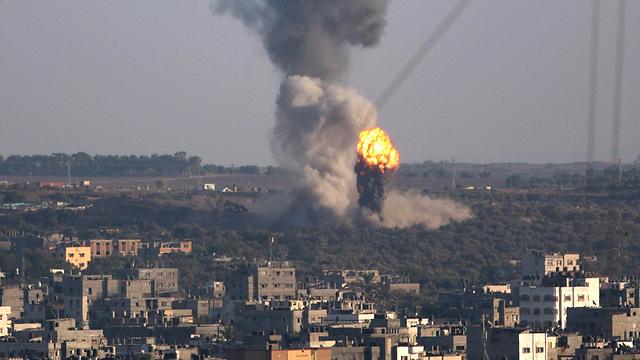Analysis: Hamas high value targets were hit following the rocket attack on the southern Israeli town of Sderot on Wednesday; hit with heavy, precision munitions, these attacks represent a change in IDF policy—immediately hit Hamas hard and fast after any rocket attack.
When the IDF hit high value targets in the Gaza Strip following a rocket attack on Sderot Wednesday, Israel was continuing its strategic policy as laid out by new Defense Minister Avigdor Lieberman—hit Hamas targets along the border with tanks as quickly as possible after a rocket attack (sometimes less than a minute later), while managing to bomb quality Hamas targets from the air within hours.
This is different than the former policy, where by the IDF would wait until nightfall to carry out its retaliatory attack, causing little damage. Even then, most of the attacks were on missile launch sites, sites which were dismantled anyway by the time the jets came to hit them.
By contrast, on Wednesday the Israeli Air Force hit Hamas targets with heavy bombs all throughout the afternoon. The airstrikes were exact, surgical, massive, and destroyed Hamas offensive strategic capabilities—capabilities that Hamas has been preparing since the end of the last war in preparation for the next one.

The IDF is currently evaluating the results of Wednesday’s attacks on Gaza. The air force hit targets including warehouses used for storing weapons equipment stores used by Hamas naval commandos.
These targets were identified months ago through the joint efforts of the Shin Bet and Israeli Military Intelligence. Destruction of these targets was enabled as a result of the “window of opportunity” provided by the rocket launch from Gaza, and due to the IDF’s newer, harsher policies regarding keeping Hamas from building up its offensive attack capabilities.

According to Israeli security assessments, Hamas is not interested in an escalation of violence, as it is fighting against the Salafi Jihadist organizations in the Strip, which are trying to undermine Hamas’s power.

Israel is also uninterested in an escalation, despite the large scale of recent attacks. In fact, Israel wants to mitigate any chance of an escalation, especially in light of the High Holy Days, during which huge numbers of Israelis travel to the south of the country.
As such, it seems that the IDF isn’t focusing its military efforts on small terror cells that launch rockets of their own accord, thereby leaving these terror cells more or less intact. This despite the fact that Sderot has been hit four times since the end of Operation Protective Edge.

However, according to IDF Chief of Staff Gadi Eisenkot, the IDF’s number one target is uncovering and destroying the Hamas “terror tunnels” that cross into Israel. Hamas allocates the majority of its budget to the construction of these tunnels. IDF efforts to mitigate the threat posed by them can be seen with new technology currently being developed and used to locate these tunnels, along with the continuing efforts of Israeli intelligence to locate and destroy these underground threats.
All this notwithstanding, though, the IDF’s new method of hitting high quality Hamas targets in real time may bring about a new threat: namely, that the Hamas military wing might start a new war sooner rather than later.
As reported by Ynetnews
